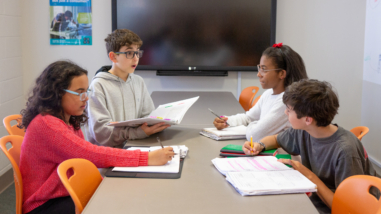Building the deeper learning field, grant by grant
 EL Education
EL Education
In 2010, the Hewlett Foundation committed to an ambitious vision for improving public education in the U.S. by ensuring underserved students develop the skills and knowledge to succeed in college, careers and civic life in the 21st century.
Education First, an advisory organization for education leaders, has had the privilege of working alongside the foundation as it implemented grantmaking strategies in support of this vision.
As part of our work, we completed a review of every work product and deliverable—from research reports to briefing papers, teaching tools to scoring rubrics, webinars to blog postings—that Hewlett grantees created over the last six years as they worked to build momentum for what has come to be known as “deeper learning.”
This review reinforced for us just how far deeper learning has come in a few short years and how it’s gelled from a disparate set of interests and beliefs into a real body of work to create an emerging, influential reform effort in public education.
It also suggests what foundations need to attend to when they commit to building a new field.
To counter-act the “shallow learning” that too many students experience — a focus on rote memorization, multiple choice tests, textbooks and curriculum that is a mile wide and inch deep — the foundation has been working to help schools adopt deeper learning. For students, it means they can develop content knowledge alongside the skills of critical thinking, communication, collaboration, learning how to learn and growth mindsets.
Back in 2010, the field of deeper learning didn’t exist. Rather, many organizations, educators, advocates, funders and leaders were committed to a potpourri of policy ideas and teaching practices that aligned in different ways with deeper learning goals: college and career readiness, standards-based reform, performance assessments, social- and emotional-and project-based learning.
Out of this potpourri has emerged a coalition of organizations that see common ground and are moving in the same direction. Endorsements of deeper learning now show up in everything from speeches by the U.S. Secretary of Education, state-developed goals for K-12 systems and the enthusiasm of hundreds of educators from across the country who attend an annual skill-building conference.
This didn’t happen by accident. It is the result of a grantmaking strategy that has sought to align the purposes of organizations across sectors within the education community to advance the goals of deeper learning from different vantage points (policy, practice, communications, etc.). Our analysis identified 107 grantees, 312 grants and more than 700 deliverables. The 10 grantees who produced the greatest number of these more than 700 deliverables include researchers (Stanford University), public policy organizations (NASBE, CCSSO and the Alliance for Excellent Education), practitioners (EL Education, Envision Education and Big Picture Company) and media outlets (American Public Media).
We also identified 17 types of deliverables, from major research studies, webinars, websites, tools, convenings, video libraries, networks/communities of practice and more.
Many of these grants were of national reach, made to organizations working with policy and education leaders across the country. Early on, they were often focused on advocacy, communications and research to frame, document and explain what deeper learning is and elevate its promise. Concurrently—but increasingly so in recent years – the foundation also invested in the creation of tools to help educators embrace and employ deeper learning practices in schools, especially the use of higher quality summative and formative assessments and instructional materials.
There is a lot to be learned here about movement-building and what philanthropy and its partners can do to foster it. The next move for advocates is likely an even stronger focus on supporting practitioners and building the capacity of school communities to implement deeper learning. Evidence suggests schools are still grappling with what it means to embrace and make explicit commitments to deeper learning. Tackling that challenge successfully will further strengthen this new field.
Editor’s note: Phil Gonring is a senior fellow and Brinnie Ramsey is a consultant at Education First.



